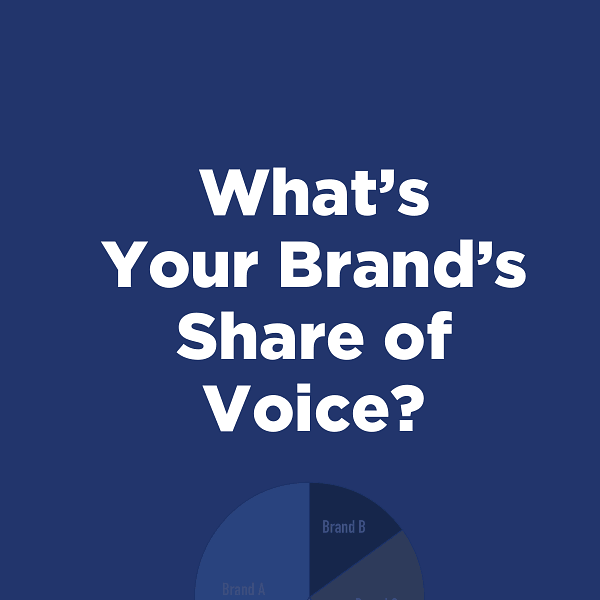What is Share of Voice?
We are all familiar with the term market share, or share of market. This is simply the percentage of all sales in your category or class of trade that belong to you. But there is another term that is equally important to understand for the long-term growth of your brand: Share of Voice (SOV).
SOV is based on the total advertising spend for your category and then calculating what percentage of that total spend you control.
As an example, if you were in the category where the annual spend of all competitors in your category is a combined $100 million dollars and your spend is $5 million, you have a 5% share of voice. (Of course, great media buying can impact this as well.)
While the explanation of SOV is fairly straightforward, there are other considerations:

Quiet vs. Contested Category
The amount of money spent in a category can swing wildly, and it’s important that you know this number. The more contested the category, the more it will cost you to be relevant. Conversely, the “quieter” the category, the easier it is for you to dominate it.

Why Does SOV Matter?
Every day, consumers are hit between 5,000 and 20,000 advertising messages. These can include everything from TV commercials to online banners to the packaging of a product. All of these devices are an attempt to get our attention and build name recognition. Of these 5,000 to 20,000 attempts to get our attention, we only mentally record about 12 of them per day.
As consumers, we only make a specific amount of bandwidth (or attention) available for remembering brands. We are simply not going to remember every brand we come into contact with.
Recall for a moment the last time you were at the grocery store. How many pasta sauces were on the shelf? Now, think back to the salad dressing aisle. Can you name every brand you saw there? Of course not… and we are in the CPG business!
While it’s true that, due to our past experiences, we may be able to tell someone what was probably on the shelf, did those items actually register in your mind that day?
The Bigger Your SOV, The Bigger Your Brand
There is a good reason the largest brands have the highest SOV and advertising budgets: because SOV in market equals market share at the shelf.
Recent ad spend matters. It isn’t enough to simply have brand name awareness: if it were, Coke would never have to advertise.
How Can A Small Brand Win?
If you are a small brand living in a category that has a $100 million total spend, your budget would need to be $10 million just to have a 10% share of voice. But what if your budget is $2 million in this $100 million world? How can you move the needle with only a 2% SOV?
The key is to target.
TARGET #1
Indicators
If your product is OTC or has a deliverable outcome, don’t try to appeal to the broadest possible audience. Define your user to a smaller, tighter demographic.
For example, let’s say your product is a topical analgesic. You cannot effectively target all pain; the key is to appeal to a single indication such as arthritis or back pain. This way, you are no longer playing in the big pool of advertising dollars (since most brands are trying to appeal to everyone). When you reduce the indications, you reduce the size of the pool your dollars are competing in.

TARGET #2
Demographic
Are you in a category with broad age and gender appeal?
Even if you are, that does not mean you have to chase everyone. How can you adjust your brand and message to appeal specifically to a certain group?
For example, let’s say you are in the mouthwash category. What if you have a formula for people over 55? Now you are competing in a much smaller pool and your budget will effectively become a march larger SOV.

TARGET #3
Narrowcast Your Message
When working with a smaller budget, it can be difficult to grab SOV across multiple media outlets. The trick here is to focus your limited dollars on a small number of outlets.
ELet’s say you are going to use television. The idea would be to stick to one or two networks where you can get some real frequency and appear to have a heavy SOV. The reality is that you do not need to be known by the entire country; to succeed, you just need to be desired by a slice that has enough people.

The bottom line to being successful in Share of Voice:
- Know your category
- Be realistic with your goals and budgets
- Use the strategies that best leverage your assets

